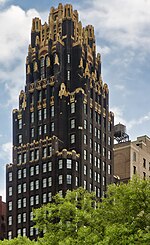Lynn Bomar
A paralyzing injury ended Bomar's college career, but he quickly recovered and sat on the bench for all of his team's games.
In his position as Tennessee's Commissioner of Public Safety and Patrol chief, Bomar supervised the ransacking of black households during the 1946 Columbia race riot.
[3] Bomar attended Webb School in his native Bell Buckle, and spent a year at Castle Heights Military Academy.
[14] Bomar's play was described: The Blonde Bear was one of the world's greatest football players, who never missed an open field block.
When one considers he made Walter Camp's All-America team when he was backing up the line on defense and blocking and catching passes on offense, his greatness is realized.
The 1921 squad was considered possibly the best in Longhorns history,[19] and Vanderbilt football seemed to be in decline when Georgia Tech defeated the Commodores 44–0 the previous year.
According to Edwin Pope's Football's Greatest Coaches, "The Texas game, sparked by McGugin's unforgettable oratory, was the big one; and Vandy got out of the year without a loss.
[24] The game against the Georgia Bulldogs decided the Southern Intercollegiate Athletic Association (SIAA) championship that season, with Bomar excelling at linebacker.
[2] The Commodores tied the Bulldogs 7–7 on a fourth-quarter onside kick for a share of the SIAA title,[26] finishing the season with a 7–0–1 record.
Another account read, "Thousands of cheering Vanderbilt fans inspired the surge of center Alf Sharp, guard Gus Morrow, tackle Tex Bradford, and end Lynn Bomar, who stopped Michigan cold in four attempts.
Bomar made an interception and caught a 23-yard pass from Jess Neely, running 20 yards[30] to set up a Gil Reese touchdown.
Georgia running back Dave Collings tackled him as he crossed the goal line (injuring himself), and Bomar also made an interception in the 12–0 Vanderbilt victory.
A fake run ended with Kuhn tossing the ball to Bomar, who was left open behind the defense and easily ran it in; Vanderbilt won, 26–0.
According to the Michigan Alumnus, Harry Kipke could not return punts for fear of fumbling; when he received the ball, Vanderbilt ends Hek Wakefield or Bomar would tackle him.
Bomar can back up a line when needed, can not be swept out by swinging interference and is powerful enough to hold his own even when big guards and tackles come at him.
Nashville sportswriter Fred Russell, who entered Vanderbilt in 1924, told a story about Bomar in his autobiography Bury Me In An Old Press Box: "As a freshman I had pledged Kappa Sigma fraternity, which at that time had many varsity athletes.
I also had the responsibility, as a freshman, of awakening Bomar in time for him to get to classes, and at the end of the school year I did this one morning by rolling the biggest lighted firecracker I ever saw under his bed.
When it exploded I feared the whole corner of the fraternity house had been blown off, and I was so scared that even Bomar in his BVD's chasing me across the street and deep into the campus couldn't catch me.
[56] The 1922–23 team had a 16–8 record, beating the LSU Tigers but losing to the Virginia Tech Hokies in the Southern Intercollegiate Athletic Association tournament.
Fans were treated to the most one-sided contest of opening day when these two clubs met, the Commodores scoring 13 points before the Louisianans had counted once, winning 36 to 10.
[61] Vanderbilt lost the next game to the eventual tournament champions, Jack Cobb and Cartwright Carmichael-led North Carolina, 37–20.
[4] Cliff Wheatley spoke of the many good catchers from which to choose for his 1922 All-Southern baseball team, "And up at Vanderbilt, Lynn Bomar made a splendid record.
[70] The financial struggle continued until the 11th game of the season, when the visiting Red Grange and the Chicago Bears drew more than 73,000 fans (a pro-football record)[71] and an additional 20,000 were turned away.
[77] From the top of the American Radiator Building to the ground in Bryant Park, a drop of 324 feet (98.75 m), Bomar completed a pass to Hinkey Haines for a record on November 12.
[80] On Bomar's first attempt, the New York Times reported that the ball "hit the sidewalk and burst"[81] and the third pass knocked Haines over.
"It was as much as anything a playful jab at Brick Muller"[78] (the Buccaneers' end), who caught a pass thrown from atop the Telephone Building—a drop of 320 feet (97.5 m)—in San Francisco the year before to advertise the first East-West Shrine Game.
In 1939 he became a division chief with the Knoxville Highway Patrol[85] and a year later became director of public safety, overseeing the city's police and fire departments.
[77] Governor Prentice Cooper promoted him to chief on a trial basis in 1942, when the incumbent went on active duty in World War II.
Later that day there was gunfire, fighting and rioting between whites and African Americans in Mink Slide, Columbia's African-American business district.
[94] Bomar supported the Prisonaires, a doo-wop quintet of inmates[96][97] who received a BMI award for their hit "Just Walkin' in the Rain" in his office.











